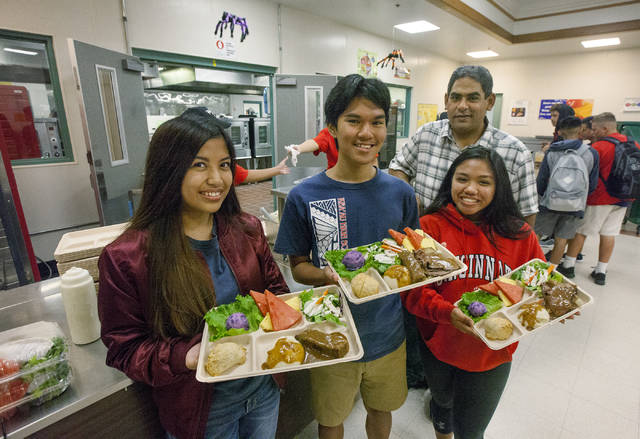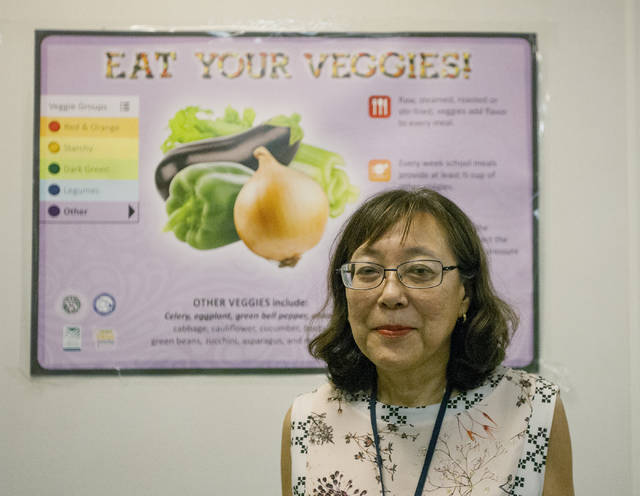Healthy plate club: Three schools to begin serving more fresh local food as part of farm-to-table program
KEAAU — Just before lunchtime Thursday, a spread of local food items was on display, soon to be served to Keaau High School students.
ADVERTISING
There was a bin of leafy greens from Honolulu sitting near a container of purple sweet potatoes grown on a farm in Pepeekeo. There also was home-style meat loaf and pot roast — both prepared using beef raised not too far away in Honokaa. Pineapple and watermelon served as sides to the meal were grown on Oahu.
“I want the community to know how we’re changing our menus and providing for our students,” said Napoleon Kailiawa, Keaau High’s cafeteria manager.
This year, Keaau High, along with Kalanianaole Elementary School and Keaukaha Elementary School, are piloting a new farm-to-table program which aims to gradually incorporate more fresh and locally produced food into school meals.
To implement the idea, food service staff at each school began requesting local items such as island-raised beef and produce from current vendors as much as possible. They next hope to forge ties with local growers and producers to buy from them directly. Staff and administrators met with a handful of island farmers this month interested in the concept and they hope to visit those farms in the future.
Eventually, the schools hope to serve up to 50 percent local items on each menu. On Dec. 1, Keaau High also is hosting an invitation-only, farm-to-table, taste and sample event to illustrate the concept for local vendors, farmers, lawmakers and agriculture industry members.
“We want to provide a nutritional and well-balanced meal for students while incorporating our local farmers,” Kailiawa said. “This would be a more healthy and better nutritional value for everybody. It’s a win-win situation.”
Every public school in Hawaii participates in the National School Lunch Program, a federal program which reimburses schools for lunches served each day so long as they adhere to established U.S. Department of Agriculture nutrition guidelines.
Some schools have said that meeting those federal guidelines — while preparing food students will still eat — can be challenging. Keaau and several other Hawaii public schools began offering students multiple menu entree choices this year in hopes of increasing participation.
Keaau also now refers to its cafeteria as a “restaurant,” Kailiawa said, and he’s rebranded certain items to have more appealing names — for example kalua and spinach to “oven-baked laulau.” He said changes have worked so far: Daily lunch participation at Keaau has more than doubled over last year.
“One of the problems is we have this stigma of cafeteria food and that cafeteria image — old and boring — just sticks to people,” Kailiawa said.
“So we want to revamp all that.”
The farm-to-table program isn’t new. Schools in the Kohala complex piloted last year the state lieutenant governor’s Farm to School Initiative, a separate program though with a similar concept.
Schools on the mainland also have farm-to-table and farm-to-school programs.
Keaau’s pilot program is still “in its infancy,” Keaau Vice Principal Ron Jarvis said. Staff are working to configure quantities needed and when certain items might be available contingent on the season, he said. Preparing fresh items also can be more costly and time consuming. For example, forming fresh-beef patties by hand takes longer than prepping frozen or canned items.
Local food still must adhere to federal nutrition standards and buying local also can be more expensive, said Lynn Hiratsuka, supervisor for the School Food Services Branch.
Hiratsuka said schools hope that additional cost will be subsidized with higher participation because the federal reimbursement increases when more students eat meals. Eventually, if successful, she hopes to see the program expand to other schools.
“Once we see how these three kitchens operate and how much produce we need and how much meat we’re using, I think that’s when we’ll start to get a better picture for the farmers of ‘What do we need and how much?’” Hiratsuka said. “I think that’s the biggest challenge. So we have to go slowly.”
“About one-third of our food is already locally grown so it’s just a matter of being more conscious and aware and being actively looking for local items,” she added. “So that’s the difference, we’re making more effort to use local.”
The program also appears to be boding well at Keaukaha Elementary School. Food service manager Gary Quirit said Thursday he’s been trying to cook more home-style items and offer more local products this year, including pineapple, sweet potatoes, island beef and watermelon.
“We’ve just been introducing more fresh and local food to these island children,” Quirit said. “They actually seem to like the fresh fruit better.”
Email Kirsten Johnson at kjohnson@hawaiitribune-herald.com.

Featured Jobs
Featured JobsHealthy plate club: Three schools to begin serving more fresh local food as part of farm-to-table program


KEAAU — Just before lunchtime Thursday, a spread of local food items was on display, soon to be served to Keaau High School students.
KEAAU — Just before lunchtime Thursday, a spread of local food items was on display, soon to be served to Keaau High School students.
There was a bin of leafy greens from Honolulu sitting near a container of purple sweet potatoes grown on a farm in Pepeekeo. There also was home-style meat loaf and pot roast — both prepared using beef raised not too far away in Honokaa. Pineapple and watermelon served as sides to the meal were grown on Oahu.
ADVERTISING
“I want the community to know how we’re changing our menus and providing for our students,” said Napoleon Kailiawa, Keaau High’s cafeteria manager.
This year, Keaau High, along with Kalanianaole Elementary School and Keaukaha Elementary School, are piloting a new farm-to-table program which aims to gradually incorporate more fresh and locally produced food into school meals.
To implement the idea, food service staff at each school began requesting local items such as island-raised beef and produce from current vendors as much as possible. They next hope to forge ties with local growers and producers to buy from them directly. Staff and administrators met with a handful of island farmers this month interested in the concept and they hope to visit those farms in the future.
Eventually, the schools hope to serve up to 50 percent local items on each menu. On Dec. 1, Keaau High also is hosting an invitation-only, farm-to-table, taste and sample event to illustrate the concept for local vendors, farmers, lawmakers and agriculture industry members.
“We want to provide a nutritional and well-balanced meal for students while incorporating our local farmers,” Kailiawa said. “This would be a more healthy and better nutritional value for everybody. It’s a win-win situation.”
Every public school in Hawaii participates in the National School Lunch Program, a federal program which reimburses schools for lunches served each day so long as they adhere to established U.S. Department of Agriculture nutrition guidelines.
Some schools have said that meeting those federal guidelines — while preparing food students will still eat — can be challenging. Keaau and several other Hawaii public schools began offering students multiple menu entree choices this year in hopes of increasing participation.
Keaau also now refers to its cafeteria as a “restaurant,” Kailiawa said, and he’s rebranded certain items to have more appealing names — for example kalua and spinach to “oven-baked laulau.” He said changes have worked so far: Daily lunch participation at Keaau has more than doubled over last year.
“One of the problems is we have this stigma of cafeteria food and that cafeteria image — old and boring — just sticks to people,” Kailiawa said.
“So we want to revamp all that.”
The farm-to-table program isn’t new. Schools in the Kohala complex piloted last year the state lieutenant governor’s Farm to School Initiative, a separate program though with a similar concept.
Schools on the mainland also have farm-to-table and farm-to-school programs.
Keaau’s pilot program is still “in its infancy,” Keaau Vice Principal Ron Jarvis said. Staff are working to configure quantities needed and when certain items might be available contingent on the season, he said. Preparing fresh items also can be more costly and time consuming. For example, forming fresh-beef patties by hand takes longer than prepping frozen or canned items.
Local food still must adhere to federal nutrition standards and buying local also can be more expensive, said Lynn Hiratsuka, supervisor for the School Food Services Branch.
Hiratsuka said schools hope that additional cost will be subsidized with higher participation because the federal reimbursement increases when more students eat meals. Eventually, if successful, she hopes to see the program expand to other schools.
“Once we see how these three kitchens operate and how much produce we need and how much meat we’re using, I think that’s when we’ll start to get a better picture for the farmers of ‘What do we need and how much?’” Hiratsuka said. “I think that’s the biggest challenge. So we have to go slowly.”
“About one-third of our food is already locally grown so it’s just a matter of being more conscious and aware and being actively looking for local items,” she added. “So that’s the difference, we’re making more effort to use local.”
The program also appears to be boding well at Keaukaha Elementary School. Food service manager Gary Quirit said Thursday he’s been trying to cook more home-style items and offer more local products this year, including pineapple, sweet potatoes, island beef and watermelon.
“We’ve just been introducing more fresh and local food to these island children,” Quirit said. “They actually seem to like the fresh fruit better.”
Email Kirsten Johnson at kjohnson@hawaiitribune-herald.com.




